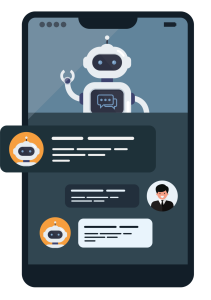As artificial intelligence continues to evolve at a rapid pace, large language models (LLMs) like ChatGPT, Claude, and Gemini are quickly becoming part of the modern workplace toolkit. These powerful tools have the potential to streamline tasks, increase productivity, and enhance creativity. From drafting reports and summarising documents to writing code and brainstorming marketing strategies, LLMs are transforming the way employees work.
One of the most pressing concerns for organisations today is the potential for data leaks when employees use these AI tools. The very capabilities that make LLMs attractive can also turn them into unintentional vectors for exposing sensitive or proprietary information. As AI becomes more embedded in enterprise operations, understanding and addressing this risk is no longer optional.
The Rise of LLMs in the Enterprise
 LLMs have surged in popularity since OpenAI launched ChatGPT in late 2022. Within months, major tech players like Google, Microsoft, and Anthropic followed with their own generative AI models. These tools are now integrated into email clients, project management software, CRM platforms, and even development environments.
LLMs have surged in popularity since OpenAI launched ChatGPT in late 2022. Within months, major tech players like Google, Microsoft, and Anthropic followed with their own generative AI models. These tools are now integrated into email clients, project management software, CRM platforms, and even development environments.
Employees are using them for tasks such as:
- Writing emails and reports
- Creating marketing copy
- Generating and debugging code
- Analysing datasets
- Translating documents
- Brainstorming ideas
The appeal is clear: LLMs save time, reduce cognitive load, and often produce high-quality output. But these models do not differentiate between safe and unsafe inputs. When employees feed them proprietary data, customer information, source code, or even HR records, they may inadvertently initiate a chain of events that leads to data leakage.
Understanding the Data Leakage Risk
 At its core, the problem stems from how LLMs operate. When a user submits a prompt to an LLM, that data is transmitted to and processed by the model’s backend infrastructure. In most cases, the model runs in the cloud. Unless the organisation is using a self-hosted or private version of the model, the data is leaving the organisation’s network and being handled by an external provider.
At its core, the problem stems from how LLMs operate. When a user submits a prompt to an LLM, that data is transmitted to and processed by the model’s backend infrastructure. In most cases, the model runs in the cloud. Unless the organisation is using a self-hosted or private version of the model, the data is leaving the organisation’s network and being handled by an external provider.
There are three primary avenues through which data can leak:
- Data retention by the LLM provider
Some LLM providers retain user prompts and use them to further train and improve the model. Although many providers claim to anonymise or aggregate data, the process is not foolproof. If an employee submits proprietary code or confidential business data, it may become part of the model’s future training corpus. This could lead to accidental redisclosure to other users. - Accidental prompt leaks
LLMs sometimes “hallucinate” outputs or reproduce memorised training data. If sensitive information has been ingested, it could resurface in responses to unrelated users. There is growing concern among security researchers that repeated exposure to proprietary data through user prompts could lead to memorisation and later unintended disclosure. - Misuse or misconfiguration
In many companies, employees use public instances of ChatGPT or similar tools without approval. Some may even copy and paste entire documents or datasets into prompts. Without oversight or training, this opens the door to unintentional leaks. Worse, some tools integrate directly into browser extensions or third-party apps, making it harder for IT to track usage.
Real-World Incidents
Several high-profile cases have highlighted the seriousness of this risk:
- Samsung: Engineers at Samsung unintentionally leaked sensitive source code and internal meeting notes to ChatGPT while using it to help with debugging. The incident led the company to restrict use of generative AI tools entirely.
- Amazon and Apple: Both companies issued internal memos warning employees not to use public AI tools like ChatGPT with confidential data, citing concerns about inadvertent information leaks.
- Law firms and financial institutions: Some legal and financial firms have caught employees pasting confidential client details into LLMs to summarise or draft communications. This violates data protection regulations and could lead to legal action.
While these organisations had the resources to respond quickly, smaller companies might not detect such issues until it is too late.
The Regulatory Landscape
Regulatory compliance adds another layer of complexity. In industries like healthcare, finance, and law, data handling is tightly regulated. Improper use of AI tools can trigger violations of laws such as:
- GDPR (EU): Any transmission of personal data outside of the EU must be tightly controlled and justified, requiring legal safeguards. These include an Adequacy Decision, Standard Contractual Clauses, Binding Corporate Rules, or an approved Code of Conduct for cloud providers. Simply sending data to a cloud-based LLM may breach these rules.
- HIPAA (US): Healthcare organisations must protect patient health information. Any AI system that processes patient health information must meet HIPAA’s Privacy and Security Rules. This means patient data must be properly protected, shared only when appropriate, and kept secure and accessible only to authorised personnel. If an employee inputs patient records into a generative AI model, it may constitute a serious violation.
- SOX and PCI-DSS: These standards require strong encryption, detailed access logs, and strict audit controls around financial/payment data. The use of public AI models without proper encryption or oversight can compromise compliance.
The legal consequences of a data breach can be severe. Fines, lawsuits, and reputational damage can all result from a single careless prompt.
Strategies for Mitigating the Risk
Despite these concerns, banning LLMs outright may not be the best solution. Employees will likely find workarounds, and the productivity benefits of generative AI are too significant to ignore. Instead, organisations should focus on implementing robust governance and training frameworks.
1. Develop a Clear AI Use Policy
Companies should create and enforce a formal policy governing the use of generative AI tools. The policy should specify:
-
Approved tools and platforms
-
Types of data that can and cannot be used
-
Required encryption and access controls
-
Approval processes for integrating LLMs into workflows
2. Use Private or On-Premise Models
For organisations handling sensitive data, deploying a private instance of an LLM (such as OpenAI’s enterprise offering or open-source models like Llama 3) may offer better control. These models can run on secure infrastructure, allowing full control over data flows and retention.
Some vendors now offer “zero retention” models that do not store prompts or outputs at all, providing additional security.
3. Implement Data Loss Prevention (DLP) Tools
Modern DLP tools can detect and block sensitive data before it leaves the organisation’s network. These tools can be integrated with browser traffic, email, and chat applications to monitor for risky behaviour.
DLP can serve as a guardrail, flagging or preventing the transmission of confidential information into unauthorised AI tools.
4. Train Employees on Safe AI Usage
Many employees use AI tools with good intentions but little understanding of the risks. Regular training sessions can help raise awareness of:
-
What data is considered sensitive
-
Why uploading certain information is dangerous
-
How to use AI tools securely
-
The organisation’s approved channels for AI use
This training should be updated regularly as AI tools evolve.
5. Monitor Usage and Audit Logs
Enterprises should monitor the usage of generative AI tools, especially in environments where data security is critical. This includes maintaining audit trails of who accessed what tools, what data was submitted, and what outputs were generated.
Monitoring helps detect risky behaviour early and can serve as evidence in the event of an investigation.
6. Apply Data Classification Systems
By tagging and classifying data based on sensitivity, organisations can apply automated controls. For example, highly sensitive documents could be blocked from being copied into AI tools, while lower-risk content might be permitted under certain conditions.
Conclusion
The integration of generative AI tools into the workplace is not a question of if, but how. While the productivity gains are undeniable, so are the risks associated with improper use. Data leaks from LLMs can expose companies to regulatory violations, competitive disadvantage, and reputational harm.
By understanding the underlying risks, learning from real-world incidents, and adopting a proactive governance strategy, organisations can safely harness the power of AI without compromising security.
AI is here to stay. The challenge now is to use it responsibly.
References
- Barbera, I. (2025). AI Privacy Risks & Mitigations Large Language Models (LLMs).
- Chiat, J., Chang, S. Y.-H., William, W., Butte, A. J., Shah, N. H., Sui, L., Liu, N., Doshi-Velez, F., Lu, W., Savulescu, J., & Shu, D. (2024). Ethical and regulatory challenges of large language models in medicine. The Lancet. Digital Health, 6(6). https://doi.org/10.1016/s2589-7500(24)00061-x
- Mok, A. (2023, July 11). Amazon, Apple, and 12 other major companies that have restricted employees from using ChatGPT. Business Insider. https://www.businessinsider.com/chatgpt-companies-issued-bans-restrictions-openai-ai-amazon-apple-2023-7
- Ray, S. (2023, May 2). Samsung Bans ChatGPT among Employees after Sensitive Code Leak. Forbes. https://www.forbes.com/sites/siladityaray/2023/05/02/samsung-bans-chatgpt-and-other-chatbots-for-employees-after-sensitive-code-leak/
- Tamanna. (2025, May 27). Understanding LLM Hallucinations. Causes, Detection, Prevention, and Ethical Concerns. Medium. https://medium.com/@tam.tamanna18/understanding-llm-hallucinations-causes-detection-prevention-and-ethical-concerns-914bc89128d0
We are Kainovation Technologies, leading the way in AI, ML, and Data Analytics. Our innovative solutions transform industries and enhance business operations. Contact us for all your AI needs.

